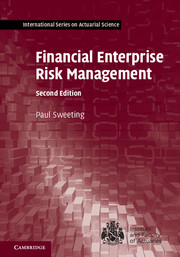Book contents
- Frontmatter
- Contents
- Preface
- 1 An Introduction to Enterprise Risk Management
- 2 Types of Financial Institution
- 3 Stakeholders
- 4 The Internal Environment
- 5 The External Environment
- 6 Process Overview
- 7 Definitions of Risk
- 8 Risk Identification
- 9 Some Useful Statistics
- 10 Statistical Distributions
- 11 Modelling Techniques
- 12 Extreme Value Theory
- 13 Modelling Time Series
- 14 Quantifying Particular Risks
- 15 Risk Assessment
- 16 Responses to Risk
- 17 Continuous Considerations
- 18 Economic Capital
- 19 Risk Frameworks
- 20 Case Studies
- 21 Solutions to Questions
- References
- Index
13 - Modelling Time Series
Published online by Cambridge University Press: 12 August 2017
- Frontmatter
- Contents
- Preface
- 1 An Introduction to Enterprise Risk Management
- 2 Types of Financial Institution
- 3 Stakeholders
- 4 The Internal Environment
- 5 The External Environment
- 6 Process Overview
- 7 Definitions of Risk
- 8 Risk Identification
- 9 Some Useful Statistics
- 10 Statistical Distributions
- 11 Modelling Techniques
- 12 Extreme Value Theory
- 13 Modelling Time Series
- 14 Quantifying Particular Risks
- 15 Risk Assessment
- 16 Responses to Risk
- 17 Continuous Considerations
- 18 Economic Capital
- 19 Risk Frameworks
- 20 Case Studies
- 21 Solutions to Questions
- References
- Index
Summary
Introduction
Many risks that are measured develop over time. As such, it is important that the ways in which these risks develop are correctly modelled. This means that a good understanding of time series analysis is needed.
Deterministic Modelling
There are two broad types of model: deterministic and stochastic. At its most basic, deterministic modelling involves agreeing a single assumption for each variable for projection. The single assumption might even be limited to the data history, for example, the average of the previous monthly observations over the last twenty years.
With deterministic approaches, prudence can be added only through margins in the assumptions used, or through changing the assumptions. A first stage might be to consider changing each underlying assumption in turn and noting the effect. This is known as sensitivity analysis. It is helpful in that it gives an idea of the sensitivity of a set of results to changes in each underlying factor, thus allowing significant exposures to particular risks to be recognised. However, variables rarely change individually in the real world. An approach that considers changes in all assumptions is therefore needed.
This leads us to scenario analysis. This is an extension of the deterministic approach where a small number of scenarios are evaluated using different prespecified assumptions. The scenarios used might be based on previous situations, but it is important that they are not restricted to past experience – a range of possible futures is considered. This is the key advantage to scenario testing: a range of ‘what if’ scenarios can be tested, whether or not they have occurred in the past. However, this does not mean that all possible scenarios can be covered – the scenarios will always be limited by what is thought to be plausible by the modeller. Another important limitation of scenario analysis is that it gives no indication of how likely a scenario is to occur. This is important when risk treatments are being considered, the cost will be considered in the context of the potential impact of the risk but also its likelihood.
The scenarios themselves might be given in quite general terms, such as ‘high domestic inflation, high unemployment’. These scenarios need to be converted into assumptions for the variables of interest. It is important that each scenario is internally consistent and that the underlying assumptions reflect both the overall scenario and each other.
- Type
- Chapter
- Information
- Financial Enterprise Risk Management , pp. 294 - 325Publisher: Cambridge University PressPrint publication year: 2017



